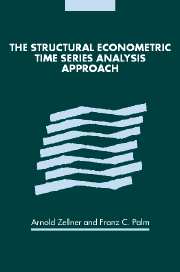Book contents
- Frontmatter
- Contents
- List of contributors
- Acknowledgments
- Introduction
- Part I The SEMTSA approach
- Part II Selected applications
- Part III Macroeconomic forecasting and modeling
- Part IV Disaggregation, forecasting, and modeling
- 20 Using Bayesian techniques for data pooling in regional payroll forecasting (1990)
- 21 Forecasting turning points in metropolitan employment growth rates using Bayesian techniques (1990)
- 22 A note on aggregation, disaggregation, and forecasting performance (2000)
- 23 The Marshallian macroeconomic model (2000)
- 24 Bayesian modeling of economies and data requirements (2000)
- Subject index
- Author index
- References
20 - Using Bayesian techniques for data pooling in regional payroll forecasting (1990)
Published online by Cambridge University Press: 24 October 2009
- Frontmatter
- Contents
- List of contributors
- Acknowledgments
- Introduction
- Part I The SEMTSA approach
- Part II Selected applications
- Part III Macroeconomic forecasting and modeling
- Part IV Disaggregation, forecasting, and modeling
- 20 Using Bayesian techniques for data pooling in regional payroll forecasting (1990)
- 21 Forecasting turning points in metropolitan employment growth rates using Bayesian techniques (1990)
- 22 A note on aggregation, disaggregation, and forecasting performance (2000)
- 23 The Marshallian macroeconomic model (2000)
- 24 Bayesian modeling of economies and data requirements (2000)
- Subject index
- Author index
- References
Summary
Introduction
This chapter adapts to the regional level a multi-country technique … used by Garcia-Ferrer, Highfield, Palm, and Zellner (1987) (hereafter GHPZ) and extended by Zellner and Hong (1987) (hereafter ZH) to forecast the growth rates in GNP across nine countries. We apply this forecasting methodology to a model of payroll formation in seven Ohio metropolitan areas. The technique applied to our regional setting involves using a Bayesian shrinkage scheme that imposes stochastic restrictions that shrink the parameters of the individual metropolitan-area models toward the estimates arising from a pooled model of all areas. This approach is motivated by the prior belief that all of the individual equations of the model reflect the same parameter values. Lindley and Smith (1972) labeled this an “exchangeable” prior.
There are several reasons to believe that the multi-country, exchangeable-priors forecasting methodology introduced by GHPZ will be successful in our multi-regional setting. First, it is well known that dependencies exist among regional economies. Numerous econometric modeling approaches have been proposed to exploit this information. Most multi-regional models take a structural approach, employing linkage variables such as relative cost, adjacent-state demand, and gravity variables. Ballard and Glickman (1977), Ballard, Glickman, and Gustely (1980), Milne, Glickman, and Adams (1980), and Baird (1983) presented multiregional models of this type. LeSage and Magura (1986) investigated a non-structural approach using statistical time series techniques to link regional models.
- Type
- Chapter
- Information
- The Structural Econometric Time Series Analysis Approach , pp. 619 - 636Publisher: Cambridge University PressPrint publication year: 2004

